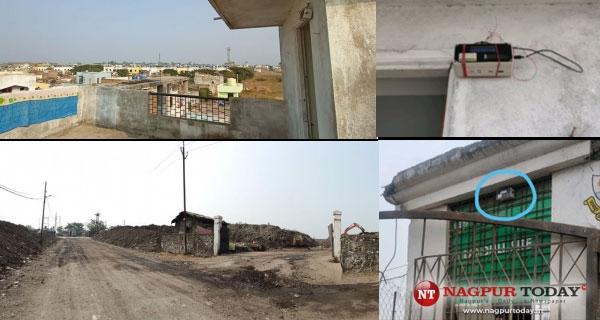
Nagpur: There is bad news if you live near the Bhandewadi Dump Yard. A two-month-long air quality monitoring study conducted by city-based NGO Centre for Sustainable Development (CFSD), Nagpur, shows that the dumping ground was substantially contaminating the air. Residents living in close proximity to the dumping ground are exposed to hazardous air for 24 hours a day.
The report titled – Air Quality Monitoring Nagpur – released on Tuesday found that the concentration of particulate matter (PM2.5) was twice as high as the national safety standards set by Central Pollution Control Board (CPCB) while it was almost 8 times higher than the World Health Organisation (WHO) revised standards in October last year.
PM 2.5 is over 30 times smaller than a human hair in size. It has the ability to travel through human lungs and cause a variety of health issues. Low vision and haze are also caused by high levels of PM 2.5.
“There has been a persistent problem of air pollution emerging from the Bhandewadi Dump Yard. The health and safety of local residents, as well as the future generations, is at risk,” said Leena Buddhe, Founder, CFSD, adding that the residents of the nearby colonies pointed out that a lot of burning activities take place inside the dump yard.
The only continuous ambient air quality monitoring station (CAAQMS) within the city is located 10 km away from the dump yard. “We were informed that the smoke produced leads to breathing discomfort and other respiratory ailments, especially among the kids and the elderly people. Since there are no air monitoring stations in this area, we undertook this two-month-long air quality monitoring exercise,” said Buddhe.
Against the CPCB standard of 60 micrograms per cubic meter (μg/m3) for 24-hours, the average daily PM2.5 concentration from December 4, 2021 to January 31, 2022 was 115.63 μg/m3. This was recorded across two monitors installed at Bhandewadi dump yard gate and Vaishno Devi layout, located 1.5 km away from the dump yard. The average reading was approximately 7.7 times higher than the WHO standard of 15 μg/m3.
For a comparison, during the same period, the average PM2.5 levels as recorded by the Maharashtra Pollution Control Board (MPCB) monitoring station at Civil Lines, which is located 10 km away from Bhandewadi, was 43.48 μg/m3.
The analysis of PM2.5 data was independently assessed by Sakshi Rajabhoj from Asar, environmental research and communications think tank.
Bhandewadi is the only dumpsite for Nagpur. It is located at a distance of 10 km from the city and is spread over an area of 77 acres of which 52 acres is used for dumping garbage while the remaining 25 acres is for the sewage treatment plant.
Buddhe said, “The entire Solid Waste Management for Nagpur was flawed as mixed waste without any segregation and treatment was being dumped at Bhandewadi and frequent fires caused at the site led to release of toxic gasses from decomposing garbage and other waste.” She also blamed this for deteriorating the air quality as well as leading to serious health concerns for those living in the vicinity and those employed inside the dumping ground.
Jyoti Waghmare a resident of Vaisnodevi Nagar Layout for 16 years said that the locals are now tired of complaining. “During rainy season the stench of decaying garbage fills the area making it difficult to even sit in the house and eat food. In summer and winter seasons the smoke from burning garbage creates huge health concerns and most people suffer from cough or other respiratory issues,” she said.
Waghmare states that most of the people want to sell their houses and leave this place forever but due to the dump yard no one wants to purchase houses here and given the health concerns the Municipal corporation should take steps to resolve this crisis.
“In children and adults, both short- and long-term exposure to PM2.5 from the Bhandewadi dumpsite can lead to reduced lung function, respiratory infections and aggravated asthma. Maternal exposure is associated with adverse birth outcomes, such as low birth weight, pre-term birth and small gestational age births. Emerging evidence also suggests ambient air pollution may affect diabetes and neurological development in children,” said interventional pulmonologist Dr Sameer Arbat adding that the Nagpur Municipal Corporation should take this matter seriously and devise plans to minimise air pollution using effective methods
Arbat added that most of the disease burden is borne by low- and middle-income groups as well as poor and marginalized communities living around such highly polluted places.
On Monday a copy of the report was submitted to the Nagpur Municipal Commissioner by CFSD.
Recommendations
The recommendations in order to control air pollution within the region as suggested by CFSD include CAAQMS in Bhandewadi, and the data should be made publicly available. “There is a need to implement better waste management practices for the entire city, with an emphasis on waste segregation. Waste processing should be taken up on a priority basis and a Material Recovery Facility needs to be set up, and the wet waste must be composted,” states the study.
Buddhe said it is recommended to ensure tree plantation in the dumpyard periphery. Awareness on air pollution and its health impact needs to increase among the dump yard workforce, and local residents, she said.
What did the study reveal:
The area around the Bhandewadi dump yard witnessed “bad air days” for the entire period of monitoring;
“The extremely high PM 2.5 levels are found to be linked with burning activities at the dump yard. The data also revealed that people at both locations were breathing polluted air for 24 hours a day. Hence, during our monitoring period, though unintentionally, we were able to shed light on the dangerously high levels of PM 2.5 concentration that people are exposed to while having to resort to creating bonfires to keep warm during the winter (December-January period),” said Rajabhoj from Asar.















